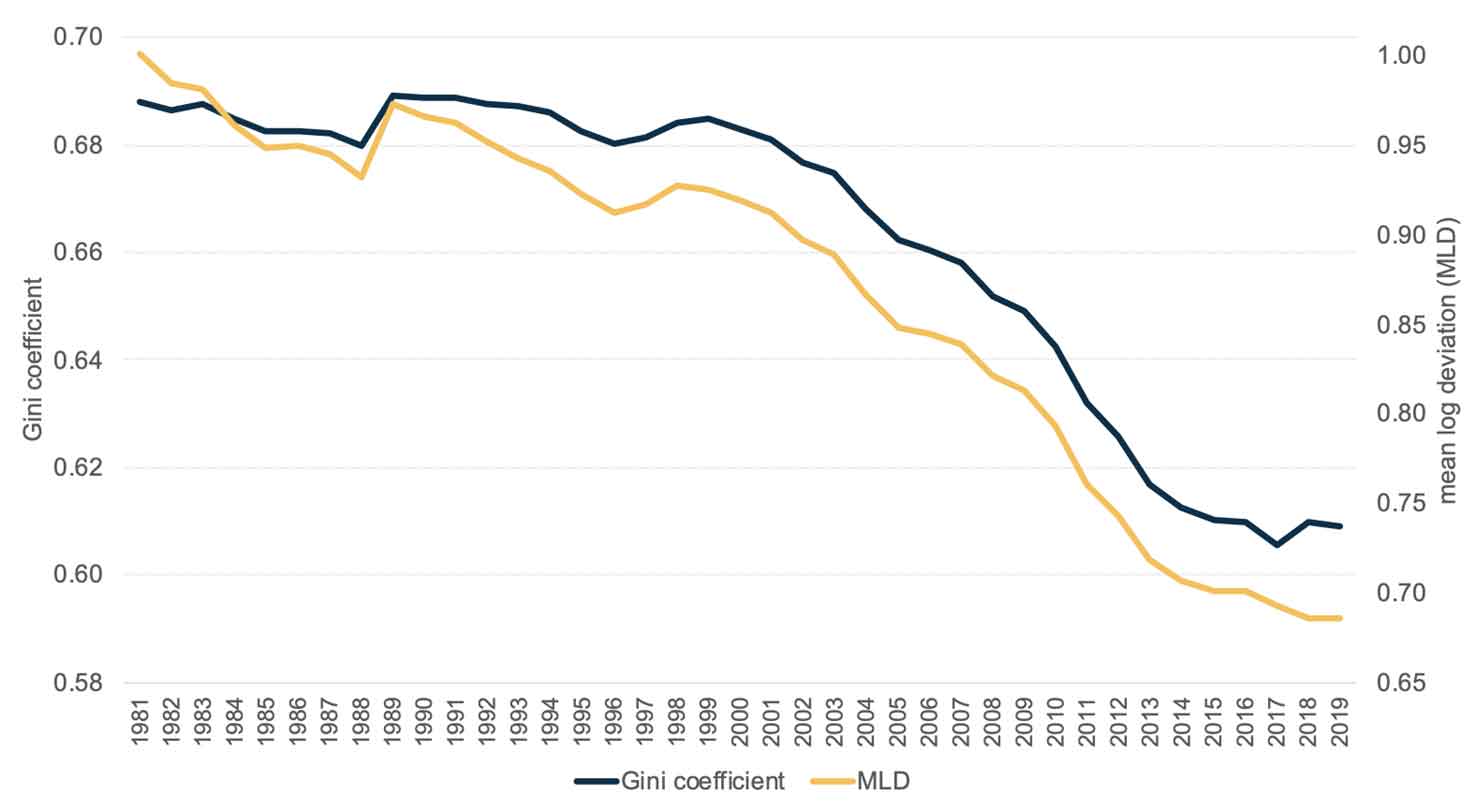Global inequality has fallen over the last three decades, despite a rise in inequality within some countries. This article uses a World Bank database covering the years 1981-2019 to posit that the decline in global inequality will reverse in the coming years, driven by the between-country component of inequality, with the unequal recovery from the Covid crisis likely to hasten the reversal. Thus, the narrative of declining global inequality could prove temporary.
Rising inequality within major economies of the world has now been well documented (Lansing and Markiewicz 2018, Kanbur 2020, Ravallion and Chen 2021, Dorn and Levell 2022). But what is happening to global inequality, meaning inequality across all citizens of the world?
Leaving to one side the Covid-19 crisis, which we will come to shortly, the broad consensus is that over the last three decades global inequality has fallen, despite the rise in inequality within large countries such as the US and China. This is discussed, for example, in the work of Anand and Segal (2005), Ravallion (2014), Bourguignon (2015), Lakner and Milanovic (2016), Niño-Zarazúa et al. (2016), and World Bank (2016). The 2016 World Bank report, based on an update of Lakner-Milanovic (2016), shows that the Gini coefficient1 fell from 69.7% in 1988 to 62.5% in 2013. There is also a consensus on the source of this decline – the fast growth of per capita income in middle-income countries such China and India, which has reduced rapidly the between-country component of global inequality, even as within-country inequality has risen in many countries.
The implications of these contrasting perspectives on inequality are not without importance in the policy domain. Thus, Rogoff (2014) argues: “The same machine that has increased inequality in rich countries has levelled the global playing field globally for billions.” This is right, since global inequality has fallen over the last three decades.
However, in our recent work (Kanbur et al. 2022) we argue that the undoubted decline in global inequality over the last decades has spurred a ‘sunshine’ narrative of falling global inequality that has been rather oversold, in the sense that it is likely to be temporary. We argue that the decline in global inequality will reverse in the coming years due to a turnaround in the between-country component of inequality. We find there is a potentially startling global inequality ‘boomerang’, possibly in the mid-to-late 2020s, which would have happened even if there were no pandemic, and that the pandemic is likely to bring forward the global inequality boomerang.
A new type of Kuznets curve
The famous Kuznets ‘inverse-U’ curve traces inequality as population within a country moves sharply from a low-income rural sector to a high-income urban sector. In this setting it is shown that overall inequality will first increase and then decrease. The empirical validity of the Kuznets inverse-U has been much debated (Anand and Kanbur 1993). However, in the global setting of the last three decades the inequality issue is not so much of population movements across countries, but rather of dramatic shifts in relative per capita incomes – which determine the between-country component of global inequality.
Intuitively, think of the world as composed of three countries: low per capita income ‘Africa’, middle per capita income ‘China’, and high per capita income ‘US’. Consider what happens to between-country inequality as China moves, in relative terms, from being close to Africa to becoming close to the US. This move increases the gap between China and Africa while reducing it between China and the US. These have opposite effects on global inequality, but since the gap between China and the US is much bigger to start with, the effect of reduction in this gap dominates and global inequality falls. However, at the other end of the process, when China is close to the US, the consequences of further closing this gap are to increase inequality.
There is thus a new type of Kuznets curve, related not to population movements but to relative growths of per capita income. It is a U-curve, not an inverse-U curve. If the middle-income country grows relative to the low-income and high-income country, global inequality will first decrease and then increase. This theoretical possibility is intuited in Ravallion (2014) and Bourguignon (2015).
So much for the intuition and the theoretical possibility. But what about the empirics? When could the turning point happen? Our work formalises the result and derives the location of the turning point for a specific measure of inequality – the mean log deviation (MLD)2. It takes into account the effects of the pandemic, and shows that the turning point could be as soon as the mid-to-end of this decade.
The ‘ten cents’ data base and past trend on inequality
In order to analyse changes in global income inequality we need household survey data that allows for a global interpersonal comparison of incomes. To this end, our paper exploits what we have termed as the ‘ten cents database’3, which has been built from the World Bank’s tool of harmonised household income and consumption surveys (Arayavechkit et al. 2021). This tool contains household income and consumption data for between 156 and 162 countries each year over the period 1981-2019, which together cover about 96% of the world’s population
Our ‘ten cents database’ produces results consistent with available evidence on the past (for example, Lakner and Milanovic 2016, Milanovic 2016, World Bank 2016). Thus, the computations from the reconstructed income distributions reveal that global income inequality, as measured by either the Gini coefficient or the MLD, has been falling markedly and steadily since the end of the 1990s and up to 2015, with a relative stagnation onwards to 2019 (Figure 1). This gives us confidence in our data set as the basis for projections of inequality, to which we now turn.
Figure 1. Evolution of global income inequality, 1981–2019

Source: Authors’ calculations based on country-year per capita income or consumption distributions reconstructed from the World Bank’s PovcalNet online tool (March 2021 update).
The future of global inequality to 2040
Projecting forward from 2019 requires us to take account of the pandemic4 We project forward with two ad-hoc growth scenarios. First, an optimistic, return to ‘pre-pandemic long-run growth’ scenario5 in which each country’s incomes will grow at the per capita annual average rate observed over 1990-2019. Second, a ‘vaccination-driven post-pandemic’ growth scenario, in which each country’s incomes will grow at a rate that depends on each country’s share of population fully vaccinated (see discussion in Deb et al. 2021, UNDP 2022a, 2022b, and on the Covid vaccination data, see Mathieu et al. 2021). The inequality projections are shown in Figure 2.
Figure 2. Evolution of global income inequality under different assumptions from 1981-2040, measured in terms of Gini coefficients (top panel) and MLD (bottom panel)

Notes: (i)Vertical lines delimit the change in income inequality between 2019 and 2020. The first scenario refers to the return to pre-pandemic long-run growth path in which it is assumed that each country’s income bins will grow at the per capita annual average rate observed over 1990-2019. (ii)The second scenario refers to the vaccination-driven post-pandemic growth path in which it is assumed that each country’s income bins will grow at a rate conditional on each country’s share of fully vaccinated people.
Source: Authors’ calculations based on country-year per capita income or consumption distributions reconstructed from the World Bank’s PovcalNet online tool (March 2021 update).
What do we find? First, between 2019 and 2020, global inequality exhibits a rise. This inequality uptick is consistent with the result reported by Yonzan et al. (2021). It is also consistent with the finding by Deaton (2021) for the concept of world inequality.6
Second, the estimates after 2020 show an unambiguous feature: there will be a reversal, or ‘boomerang’, in the recent declining global inequality trend by the early-2030s. Under the first scenario, the declining trend recorded since 2000 would reach a minimum by the end of the 2020s, followed by the emergence of a global income inequality boomerang. If, on the other hand, growth is linked to countries’ share of fully vaccinated population (the second scenario), a startling result emerges: the inequality boomerang would occur around 2024 based on the Gini coefficient, while it may be happening immediately after the first year of the pandemic based on the MLD.
The above boomerang results emerge from an analysis which assumes that inequality within each country remains unchanged. In other words, that growth for each country is ‘distribution-neutral’. In our detailed work, we also present inequality projections for growth that is not distributionally neutral within each country, by assuming that the change across deciles between the last two surveys persists into the future. We find that the boomerang in global inequality emerges sooner, and well before the end of this decade.
Conclusion
Our results point towards the potential of a startling global inequality ‘boomerang’ toward the late-2020s or the early-2030s, driven by the path of between-country inequality, as middle-income countries approach income levels of high-income countries but by the same token pull away from low-income countries.
The global inequality boomerang could occur sooner if the access to Covid-19 vaccines across the developing world – which likely prevents a full economic recovery and growth potential – remains unequal. Projections which further extrapolate recent patterns of distributional non-neutral growth show that the upward turn in global inequality could come even sooner.The conclusion is that the ‘sunshine narrative’ of declining global inequality needs to be tempered. An inequality boomerang is quite likely.
A version of this article first appeared on VoxEU.
Notes:
- Gini coefficient is a measure of statistical dispersion, mainly used to enumerate income inequality. It is measured on a scale of 0 to 1; with 0 indicating perfect equality and 1 indicating maximal inequality.
- MLD is zero when everyone has the same income, and takes larger positive values as incomes become more unequal.
- To retrieve each country-year distribution, the algorithm computed the cumulative share of the population with per capita income or consumption below an array of monetary thresholds that change in value every $0.10 a day per person (in 2011 PPP), starting from $0.10 up to a maximum value that covers 99.99% of the population. From these cumulative shares, individuals within each $0.10-bin (Statistical data binning is a way to group numbers of more-or-less continuous values into a smaller number of ‘bins’) were isolated and then assigned the middle value of their bin as their daily amount of per capita income or consumption.
- Following the Lakner et al. (2020) method, we project forward the global distribution of income (or consumption) in 2019 by applying a pass-through rate of 85% of the country’s GDP per capita growth rate between that year and 2020. Then, for the period 2021-2040, the computation of inequality indices results after each country’s income is extrapolated following the approach of Prydz et al. (2019). That is, each income in the distribution is multiplied by a factor that represents the corresponding country’s annual growth rate. The analysis accounts for demographic changes by assuming that the population share at each income level grows yearly at that country’s population growth rate projected by the UN World Population Prospects for the period 2020-2040.
- In the spirit of Pritchett and Summers’ (2014) argument on ‘regression to the mean’
- That is, in which each individual in the world is assigned their corresponding country’s GDP per capita
Further Reading
- Anand, Sudhir and S. M. R. Kanbur (1993), “Inequality and Development. A Critique”, Journal of Development Economics, 41(1): 19-43.
- Anand, S and P Segal (2015), ‘The Global Distribution of Income’, In AB Atkinson and F Bourguignon (eds), Handbook of Income Distribution Vol 2.
- Arayavechkit, Tet al. (2021), ‘March 2021 PovcalNet Update. What’s New’, Global Poverty Monitoring Technical Note 15, World Bank.
- Bourguignon, F (2015), The Globalization of Inequality, Princeton University Press, Princeton, NJ.
- Deaton, Angus (2021), “COVID-19 and Global Income Inequality”, LSE Public Policy Review,1(4): 1-10.
- Deb, P, D Furceri, D Jimenez, S Kothari, JD Ostry and N Tawk (2021), ‘The Effects of COVID-19 Vaccines on Economic Activity’, IMF Working Paper WP/21/248.
- Dorn, D and P Levell (2022), ‘Changing views on trade’s impact on inequality in wealthy countries’, VoxEU, 14 February 2022.
- Kanbur, R (2020), ‘An Age Of Rising inequality? No, But yes’, VoxEU, 21 September 2020.
- Kanbur, R, E Ortiz-Juarez and A Sumner (2022), ‘The Global Inequality Boomerang’, CEPR Discussion Paper 17105.
- Lakner, Christopher and Branko Milanovic (2016), “Global Income Distribution: From the Fall of the Berlin Wall to the Great Recession”, The World Bank Economic Review,30(2): 203-232.
- Lakner, C, DG Mahler, M Negre and EB Prydz (2020), ‘How Much Does Reducing Inequality Matter for Global Poverty?’, Global Poverty Monitoring Technical Note 13.
- Lansing, K and A Markiewicz (2018), ‘Rising American inequality: New evidence on winners and losers’, VoxEU, 21 April 2018.
- Mathieu, Edouard, Hannah Ritchie, Esteban Ortiz-Ospina, Max Roser, Joe Hasell, Cameron Appel, Charlie Giattino and Lucas Rodés-Guirao (2021), “A Global Database of COVID-19 Vaccinations”, Nature Human Behaviour, 5(7): 947-953.
- Milanovic, B (2016), Global Inequality: A New Approach for the Age of Globalization, Harvard University Press,Cambridge, MA.
- Niño-Zarazúa, M, L Roope and F Tarp (2016), ‘Income inequality in a globalising world’, VoxEU, 20 September 2016.
- Pritchett, L and L Summers (2014), ‘Asiaphoria Meets Regression to the Mean’, NBER Working Paper 20573.
- Prydz, EB, D Jolliffe, C Lakner, D G Mahler and P Sangraula (2019), ‘National Accounts Data Used in Global Poverty Measurement’, Global Poverty Monitoring Technical Note 8.
- Ravallion, Martin (2014), “Income Inequality in the Developing World”, Science,344(6186): 851-855.
- Ravallion, M and S Chen (2021), ‘China’s new goal for income distribution: Some insights from survey data back to 1981’, VoxEU, 15 November 2021.
- Rogoff, K (2014), ‘Where is the Inequality Problem?’, Project Syndicate, 8 May 2014.
- UNDP (2022a), ‘Impact of Vaccine Inequity on Economic Recovery’, United Nations Development Programme.
- UNDP (2022b), ‘Global Dashboard for Vaccine Equity’, United Nations Development Programme.
- World Bank (2016), ‘Poverty and Shared Prosperity 2016: Taking on Inequality’, World Bank.
- Yonzan, N, C Lakner and D G Mahler (2021), ‘Is COVID-19 Increasing Global Inequality?’, Data Blog, World Bank Blogs, 7 October 2021.
Social media is bold.
Social media is young.
Social media raises questions.
Social media is not satisfied with an answer.
Social media looks at the big picture.
Social media is interested in every detail.
social media is curious.
Social media is free.
Social media is irreplaceable.
But never irrelevant.
Social media is you.
(With input from news agency language)
If you like this story, share it with a friend!
We are a non-profit organization. Help us financially to keep our journalism free from government and corporate pressure
















0 Comments